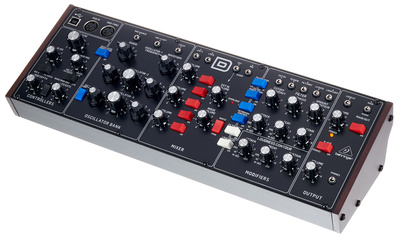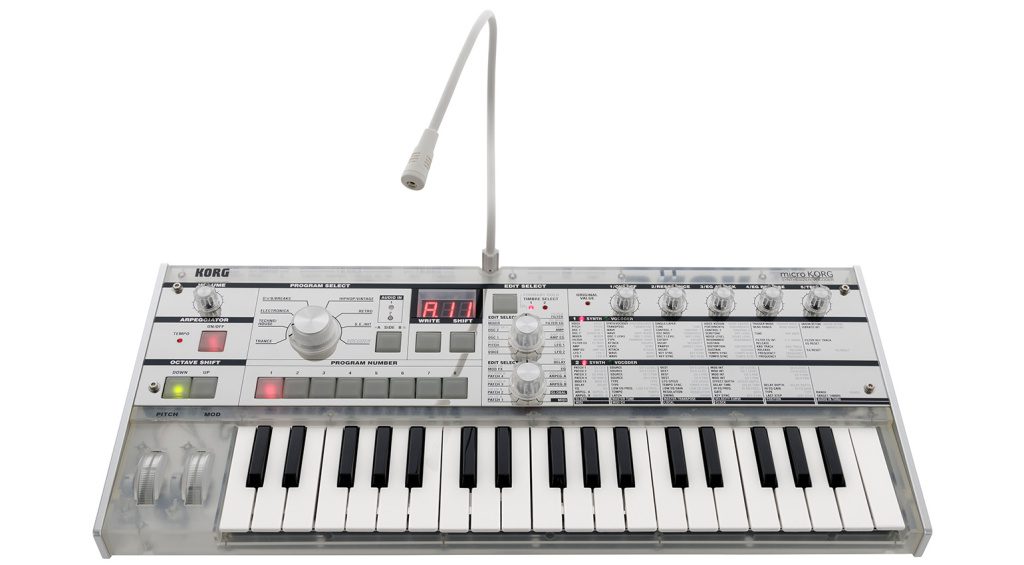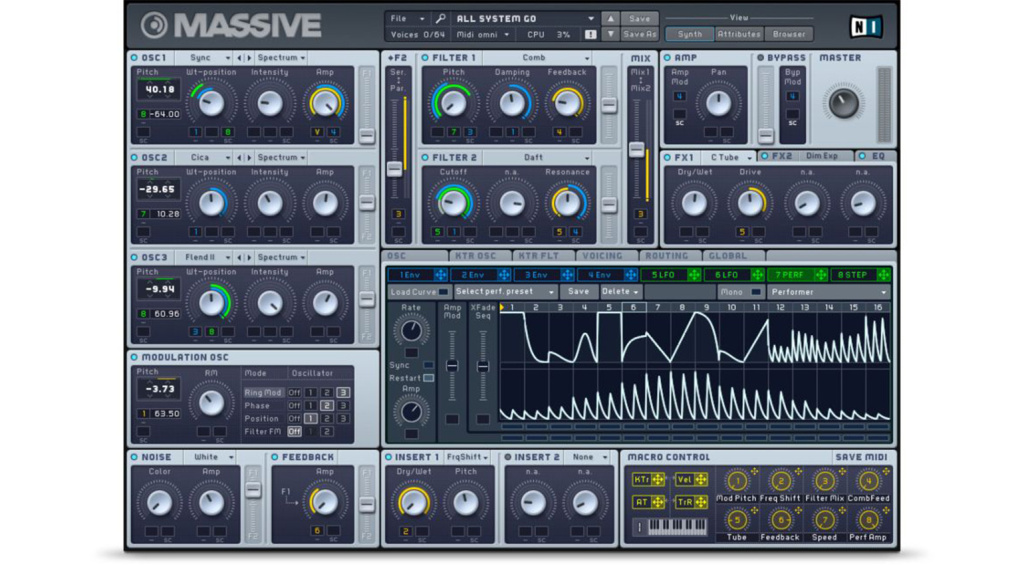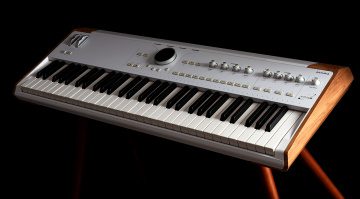Iconic Synths: 10 Game-Changing Synthesizers
Synthesizers that changed everything.
These are the iconic synths that made the biggest impact on music – and how you can get their sound even today.
Iconic Synths
Every year, the musical instrument industry releases countless synthesizers. And yet some make a bigger impact than others. Even fewer make the biggest impact. These are the ones we’re celebrating today, the iconic synths that changed not only the music that we listen to but also how synthesizers themselves were made.

For convenience’s sake, I’ve chosen two synths per decade. Sometimes the choices were easy; other times I had to cut some out that I really wanted to include. If I omitted your favorite, I apologize. But I’m sure you’ll tell me all about it in the comments.
For the sake of space and my own busy life, I’ve decided to stop with the decade from 2000-2009. Anything later than that feels like the current day, and I just wrote a story about that very thing: Modern Synth Classics.
Many of the iconic synths in this list have modern versions, either hardware or software, and I’ve included some in the text. Can we just take a moment and be thankful that we live in a time where so many of these amazing instruments are back on the market?
Iconic Synths: 1960s
Although there were a few electronic instruments before the 1960s, this was the decade when ‘synthesizer’ as a concept really came into its own thanks to the endeavors of one Bob Moog. The Moog Modular systems – available as separate modules or complete systems like the IIIc – soon captured the ears and hearts of listeners and musicians alike, with Moogs soon gracing records by the Monkees, the Doors and the Beatles.

Modern musicians looking to capture some of this early Moog magic can try Arturia’s Modular V. On the hardware side, although it’s referencing a ‘70s system, the Behringer System 55 is an affordable modular rig in Eurorack format.

As incredible as the Moog Modular systems were, they were prohibitively expensive and hardly portable. In 1969, British company EMS released a modular that addressed both these issues, the VCS3. It and its suitcase-bound follow-ups the Synthi A and Synthi AKS (both 1971), were even more popular. For modern takes on the VCS3, try Erica Synth’s Syntrx II or Arturia’s Synthi V.
Other iconic synths from this decade: Buchla 100 Series










Iconic Synths: 1970s
If the 1960s were synthesizers coming into being, the 1970s saw them hitting their stride, with companies popping up all over the US, Japan and Europe.
The first big synth release of the decade was the Moog Minimoog in 1971. With its design and signal flow helping to establish what a synthesizer could be, it managed to be both great-sounding and eminently playable. Fifty-three years on, it’s still a coveted instrument, as evidenced by Moog’s official remakes, the many clones and all of the software emulations.

By 1977, analog polyphony was the big thing but no one had managed to make one with programmable memory. Enter the Sequential Circuits Prophet-5, a gorgeous five-voice poly with a Z80 chip to back up patches. It was an instant hit and became the sound of the late 1970s and early 1980s. If you have the money and you want new, the Sequential remake is the way to go. On the software side, both Arturia’s Prophet-5 V and U-he’s Repro-5 sound fantastic.

Other iconic synths from this decade: ARP 2600, ARP Odyssey, Yamaha CS-80, Oberheim Eight Voice, Korg MS-20











Iconic Synths: 1980s
Powered by the microprocessor revolution, the 1980s saw an explosion in the number of synthesizer releases, particularly polys. It was also when Japan really emerged as a global player in consumer electronics, including synths. In fact, both of the iconic synths here are from Japanese manufacturers.

Although subtractive analog would continue to be a viable synthesis architecture throughout the 1980s, it was digital that would really shake things up, first in the form of FM and later with sampling. Accordingly, Yamaha’s DX7 is my choice for the first iconic synth of the 1980s. Released in 1983, it had an immediate and long-lasting effect, with its clean FM sounds becoming all the rage.

Yamaha would do exceedingly well with the DX7 and its many sub-variants for most of the 1980s but may have leaned a little too heavily on FM, as it missed the starting gun for sample synthesis. The winner of that race, at least in terms of the 1980s, was Korg, whose 1988 M1 was the king of the late ‘80s. Including a sequencer and drum sounds together as a workstation made it all the more popular.
There are software versions available for both of these iconic synths. Arturia’s DX7 V augments the classic DX FM sound with extra parameters while Korg’s M1 sounds just like you remember.
Other notable iconic synths from this decade: Roland Jupiter-8, PPG Wave, Roland Juno-60, Roland D-50


Iconic Synths: 1990s
The 1990s saw the digital advancements made in the previous decade continue, with sample synthesis – and in particular ROMplers – gaining ever more popularity. Korg’s Trinity line graduated up to the Triton in 1999, becoming the go-to instrument for pop and hip-hop producers like the Neptunes and Timbaland.

The other big trend in the 1990s was virtual analog. Thanks to the growing popularity of dance music and producers wanting hands-on control, manufacturers took physical modeling, used it to recreate analog synths rather than violins and marimbas, and virtual analog was born. Clavia coined the term with its Nord Lead in 1995, opening the gate for others like Roland and Korg to follow.

To get that lush Triton ROMpler sound today, Korg’s official software version is the way to go. For the Nord, try the Nord Lead A1, the latest in a long like of red synths from the Swedish company.
Other notable iconic synths from this decade: Dopefer A-100, Native Instruments Reaktor 2.0, Roland JP-8000



Iconic Synths: 2000s
The first decade of the new millennium saw the industry coasting. The big manufacturers continued to release sample-based and VA digital synths, with refinements and reiterations rather than new forms of synthesis the overriding theme of the 10-year period.

That’s not to say there weren’t some hardware classics though. In 2002, Korg dropped the MicroKorg, an unassuming little virtual analog synth that – despite its lack of hands-on control and focus on (now very outdated) musical genres – it became a runaway success. In fact, it’s still in production 24 years later and periodically gets released in fancy new liveries. Not bad for a cut-down version of the MS-2000, itself a digital remake of the MS-20.
The big waves in the aughts did not come from hardware, however, but software. This is the time when in-the-box production really took off, with DAWs and VSTs coming into their own. Massive from Native Instruments, which debuted in 2006, was all over dance records, its wavetable-powered sounds at the heart of new genres like dubstep. Its influence can still be felt today in modern software like Serum and Vital.

For a modern take on the sound of the aughts, you don’t have to work very hard as both the MicroKorg and Massive are still readily available. You can even get a software version of the MicroKorg if you prefer.
Other notable iconic synths from this decade: Virus TI, Moog Voyager









More Information
- All about synthesizers

 4,4 / 5,0 |
4,4 / 5,0 | 









